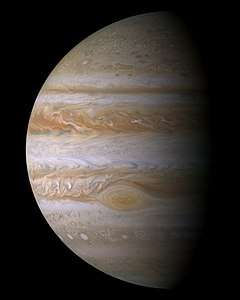2010 Jupiter impact event
The 2010 Jupiter impact event was a bolide impact event on Jupiter by an object estimated to be about 8–13 metres (26–43 ft) in diameter.[1] The impactor may have been an asteroid, comet, centaur, extinct comet, or temporary satellite capture.
 Observations made by NASA's Hubble Space Telescope | |
| Date | 3 June 2010 |
|---|---|
| Location | Jupiter |
Observation
The impact happened 3 June 2010, and was recorded and first reported by amateur astronomer Anthony Wesley from Australia. The event was confirmed by Christopher Go at the Philippines, who recorded the event, and has released a video.[2][3][4] Wesley is the same person who had been first to report the 2009 Jupiter impact event.
The observed flash lasted about two seconds.[2][5] It was located in the South Equatorial Belt, about fifty degrees from the central meridian.[6] The June 2010 superbolide impactor probably measured between 8 and 13 metres (26 and 43 ft) across, with a mass between 500 and 2,000 tonnes (490 and 1,970 long tons; 550 and 2,200 short tons).[7] Jupiter probably gets hit by several objects of this size each year.[7]
On 20 August 2010 UT, yet another flash event was detected on Jupiter.[8] As of 23 August two other observers had recorded the same event.[9]
Other impacts
1994 impact
In July 1994 the Comet Shoemaker–Levy 9 broke apart and collided with Jupiter, resulting in a series of hits. This incident had been predicted in advance.
2009 impact

On 19 July 2009 an impact was observed, which caused a black spot on Jupiter's atmosphere. This unpredicted event was first reported by Anthony Wesley, who also first observed the 2010 event.[2] The 2009 impact has been studied by NASA's Hubble Space Telescope, and the study suggests that the observed incident was a hit by an asteroid about 500 metres (1,600 ft) wide.[11]
2012 impact
On 10 September 2012 at 11:35 UT amateur astronomer Dan Petersen visually detected a fireball on Jupiter that lasted 1 or 2 seconds using a Meade 12″ LX200.[12] George Hall had been recording Jupiter with a webcam on his 12" Meade; upon hearing the news Hall checked the video to see if the impact was captured. Hall had indeed captured a 4-second clip of the impact and released the video to the public. The impact's estimated position in the system was longitude = 345 and latitude = +2.[13] Dr Michael H. Wong estimated that the fireball was created by a meteoroid less than 10 metres (33 ft) in diameter.[13] Several collisions of this size may happen on Jupiter on a yearly basis.[13] The 2012 impact was the 5th impact observed on Jupiter, and the fourth impact seen on Jupiter between 2009 and 2012. It was quite similar to the flash observed on 20 August 2010.[12]
References
- Hueso, R.; A. Wesley; C. Go; S. Pérez-Hoyos; M. H. Wong; L. N. Fletcher; A. Sánchez-Lavega; M. B. E. Boslough; I. de Pater; G. S. Orton; et al. (2010). "First Earth-based Detection of a Superbolide on Jupiter". The Astrophysical Journal. 721 (2). arXiv:1009.1824. Bibcode:2010ApJ...721L.129H. doi:10.1088/2041-8205/721/2/L129.
- Sayanagi, Kunio M. (3 June 2010). "Jupiter hit by another impactor Thursday". Ars Technica. Archived from the original on 5 June 2010. Retrieved 4 June 2010.
- Bakich, Michael (4 June 2010). "Another impact on Jupiter". Astronomy Magazine online. Retrieved 4 June 2010.
- http://www.christone.net/astro/jupiter/index.htm
- "Australian amateur astronomer Anthony Wesley films Jupiter impact". The Daily Telegraph. 5 June 2010. Retrieved 4 June 2010.
- Rogers, John H. "New impact on Jupiter before & after". British Astronomical Association. Archived from the original on 9 June 2010. Retrieved 4 June 2010.
- "WITHOUT A TRACE – A FLASH IN JUPITER'S SKY". Gemini Observatory. 9 September 2010. Archived from the original on 18 September 2010. Retrieved 9 September 2010.
- "Optical flash on Jupiter". Archived from the original on 25 August 2010. Retrieved 23 August 2010.
- Beatty, Kelly (22 August 2010). "Another Flash on Jupiter!". Sky & Telescope. Sky Publishing. Retrieved 23 August 2010.
Masayuki Tachikawa was observing ... 18:22 Universal Time on the 20th ... Kazuo Aoki posted an image ... Ishimaru of Toyama prefecture observed the event
- Dennis Overbye (24 July 2009). "Hubble Takes Snapshot of Jupiter's 'Black Eye'". The New York Times. Retrieved 6 June 2010.
- "Hubble Images Suggest Rogue Asteroid Smashed Jupiter". 3 June 2010. Archived from the original on 7 June 2010. Retrieved 4 June 2010.
- Franck Marchis (10 September 2012). "Another fireball on Jupiter?". Cosmic Diary blog. Retrieved 11 September 2012.
- Franck Marchis (11 September 2012). "Flash on Jupiter – most likely a meteor". Cosmic Diary blog. Retrieved 29 November 2012.
- Plait, Phil (29 March 2016). "Jupiter Got Whacked by Yet Another Asteroid/Comet!". www.slate.com. Retrieved 12 April 2016.
- Dvorsky, George (29 March 2016). "Something Just Slammed Into Jupiter". gizmodo.com. Retrieved 12 April 2016.
External links
| Wikimedia Commons has media related to Jupiter 2010 impact event. |
- Wesley, Anthony. "Jupiter Impact on June 3, 2010". Archived from the original on 7 June 2010. Retrieved 4 June 2010.
- Go, Christopher. "Jupiter 2010". Archived from the original on 1 June 2010. Retrieved 4 June 2010.
